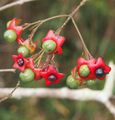Biology:Clerodendrum floribundum
| Lolly bush | |
|---|---|

| |
| tree at Mount Archer National Park, Australia | |
| Scientific classification | |
| Kingdom: | Plantae |
| Clade: | Tracheophytes |
| Clade: | Angiosperms |
| Clade: | Eudicots |
| Clade: | Asterids |
| Order: | Lamiales |
| Family: | Lamiaceae |
| Genus: | Clerodendrum |
| Species: | C. floribundum
|
| Binomial name | |
| Clerodendrum floribundum R.Br.
| |
Clerodendrum floribundum, known as the lolly bush or smooth clerodendrum, is a shrub or tree found in Australia and New Guinea. The habitat is in or at the margins of coastal rainforests, up to 300 metres above sea level. In Western Australia it grows in drier areas; such as rocky sites, gorges, cliffs, floodplains and creek beds.[1]
The leaves may be drawn into a blunt tip, a prickle or a sharp tip. They are variable in shape, usually 4 to 15 cm long, 2 to 6 cm wide. The young leaves are not as hairy as with the related downy chance. The generic term Clerodendrum is from the Greek, meaning "lottery tree". The term "lottery" refers to an unsure possibility of a medicinal value from plants of this genus. The specific epithet floribundum refers to the abundance of flowers in showy heads. The fruit is a black drupe, growing on an enlarged red fleshy calyx. It appears glossy and succulent, giving rise to the common name "lolly bush".
Usually a small tree, however it has been recorded at 30 metres tall with a stem diameter of 30 cm at Booyong Flora Reserve, in northern New South Wales.[2] White fragrant flowers form in cymes between September and December.
There is some debate whether this plant is found in rainforests of the Illawarra. A.G.Floyd says it is found as far south as Batemans Bay and growing north to Cape York at the northernmost point of the continent. Then west through the Northern Territory and Western Australia.[3] However, the Royal Botanic Gardens, Sydney say records in the far south east may not be accurate.[4]
The leaves are host to the caterpillar of the Fiery Jewel Butterfly.
Regeneration is from fresh seeds or cuttings. It is an easy plant to grow, requiring plenty of water. In 1810, this species first appeared in scientific literature, in the Prodromus Florae Novae Hollandiae, authored by the prolific Scottish botanist, Robert Brown. Originally collected on the voyage of Captain Cook's ship, the Endeavour.[5]
Several varieties appear in publications[citation needed], such as:
- Clerodendrum floribundum var. floribundum
- Clerodendrum floribundum var. attenuatum
- Clerodendrum floribundum var. latifolium
- Clerodendrum floribundum var. coriaceum
- Clerodendrum floribundum var. angustifolium
leaves, Mount Keira, Australia
References
- ↑ "Clerodendrum floribundum". Conservation and Land Management, Western Australia. http://florabase.calm.wa.gov.au/browse/profile/6729.
- ↑ Floyd, Alexander G. (1990). Australian Rainforests in New South Wales. 2. Chipping Norton, Australia: Surrey Beatty & Sons (published 1990-08-31). p. 179. ISBN 0-949324-32-9. https://books.google.com/books?id=AqXwAAAAMAAJ&q=Clerodendrum+floribundum. Retrieved 2010-12-28. (other publication details, included in citation)
- ↑ Floyd, A. G. (2008). Rainforest Trees of Mainland South-eastern Australia (2nd, Revised ed.). Lismore, New South Wales: Terania Rainforest Publishing. p. 171. ISBN 978-0-958943-67-3. http://rainforestpublishing.com.au/shop/rainforest-trees-of-south-eastern-australia/. Retrieved 2010-12-28.
- ↑ *"Clerodendrum floribundum". PlantNET - NSW Flora Online. http://pngplants.org/cgi-bin/NSWfl.pl?page=nswfl&lvl=sp&name=Clerodendrum~floribundum.
- ↑ "Archived copy". http://seachestsecret.questacon.edu.au/assets/list_of_plants_collected_on_endeavour_and_resolution_ii.pdf.
Wikidata ☰ Q5131941 entry
 |




